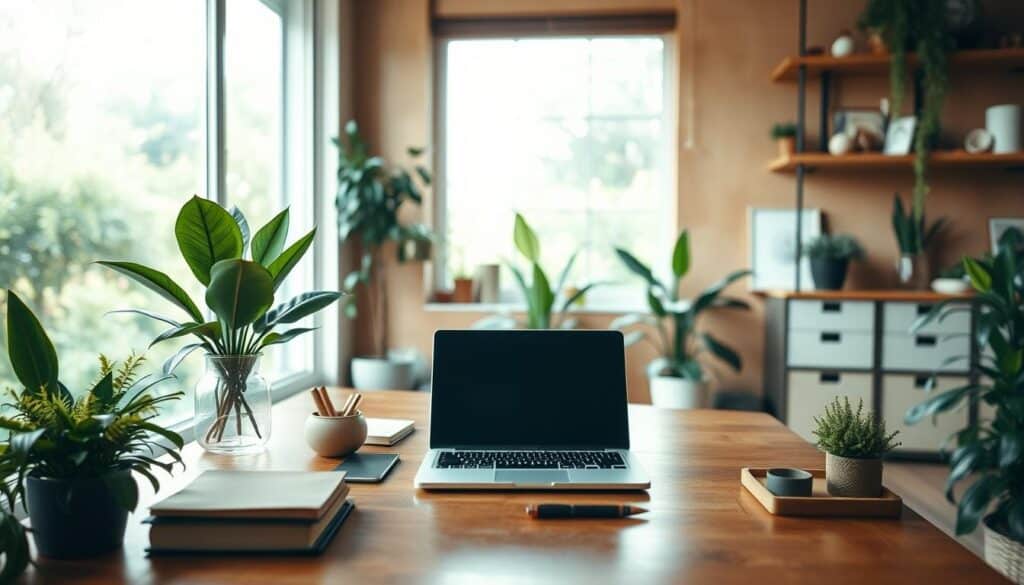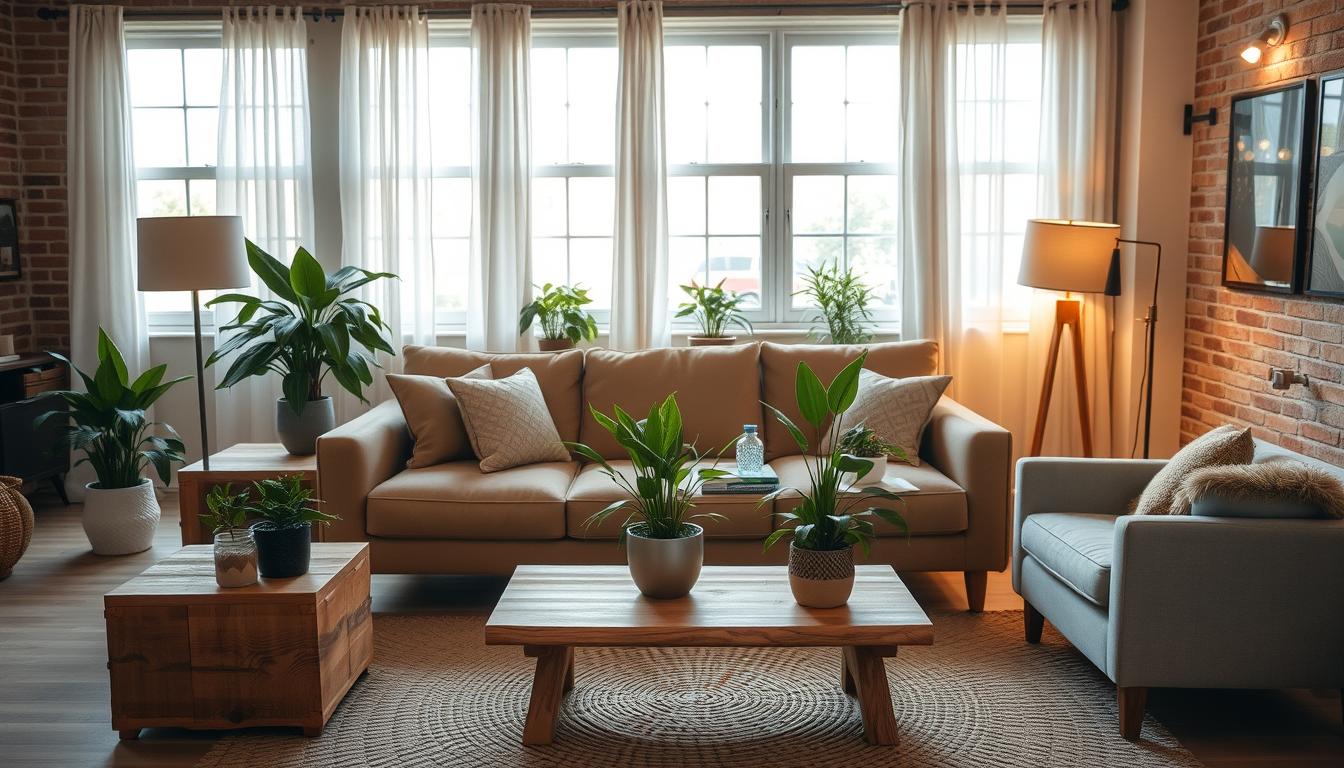In today’s busy world, organic workspaces are more important than ever. They bring together natural elements and smart design. This boosts productivity and puts employee well-being first.
These spaces are based on biophilic design principles. They help people feel closer to nature. This can lead to better work and more happiness.
More and more, companies see the value in spaces that are not just nice to look at but also good for health. Because of this, sustainable office design is becoming very popular.
What Are Organic Workspaces?
Organic workspaces are spaces designed to be in harmony with nature, boosting the mood and productivity. This approach to office design mixes natural elements into the workspace. This can help employees feel better and work more efficiently.
Defining Organic Workspaces
Organic workspaces aim to build sustainable work environments. They do this by letting in lots of natural light, adding indoor plants, and using materials that are good for the earth. These designs take cues from green office concepts to reduce harm to the environment while increasing employee comfort. In these places, team members find it easier to work together and be more creative.
Key Features of Organic Designs
Knowing what makes an organic design can really improve an office. Important features include:
- Large windows allowing for increased natural lighting
- Open layouts that promote airflow and easy communication
- Use of sustainable materials, such as reclaimed wood and recycled surfaces
- Incorporation of biophilic elements like indoor plants and water features
- Flexible workstations to accommodate various work styles
These elements make the workplace more relaxing and enjoyable. This leads to happier employees who stay with the company longer and perform better.

The Benefits of Organic Workspaces
Organic workspaces turn old-style offices into places that focus on wellness. They mix natural parts and smart design. This makes a healthy atmosphere that boosts well-being.
Workers feel less stressed, happier with their jobs, and more connected to their space. Organic workspaces aren’t just nice to look at. They help both mind and body health.
Enhanced Employee Well-Being
Nature in work areas brings peace and calm. Green plants and sunlight make work more pleasant. This focus on well-being keeps staff lively and aware all day.
It leads to a happy work environment. Better wellness means workers are happier and more motivated.
Improvement in Air Quality
Clean air is vital for employee health. Organic workspaces use plants to clean the air and add oxygen. This makes a healthier workplace, lowering sickness and breathing problems.
Studies show that health-focused designs lead to fewer sick days and more work done. Organic workspaces really do make a big difference.
Organic Workspaces for Enhanced Productivity
Adding natural elements to office spaces boosts productivity. Nature has a big role in making work areas better for health and work. Having plants, sunlight, and nature-inspired designs helps people concentrate and be creative.
How Nature Elements Influence Productivity
Studies show that greenery and sunlight boost brain power. Being around nature helps employees focus more and feel less tired. By bringing nature inside, workplaces help employees think better and stay energetic. Companies that use natural designs see their teams work better and come up with new ideas.
Reducing Stress Through Natural Designs
Nature-inspired designs lower stress at work. They make the office feel calm, which reduces stress and helps everyone stay focused. Happy and engaged workers lead to better performance for the whole company.
Tips for Creating an Organic Workspace
Designing an organic workspace means adding natural elements thoughtfully. A few smart choices can make the work environment healthier and more productive.
Incorporating Indoor Plants
Adding indoor plants is a great tip for an organic workspace. Choose plants like peace lilies, pothos, or rubber plants to make the area look nice and clean the air. These plants can make the atmosphere lively and encourage workers.
Maximizing Natural Light
It’s important to let in as much natural light as possible. Putting in big windows or skylights can make the office brighter and save on energy bills. Using shiny surfaces to spread the light around can make the place feel better, helping everyone work happily and more efficiently.
Utilizing Natural Materials
Using natural materials is key for a pleasing environment. Adding things like wood, stone, and natural fabrics creates a cozy and attractive space. This approach looks good, is better for the planet, and shows a commitment to being eco-friendly.
The Role of Biophilic Design in Workspaces
Biophilic design is key in making workspaces that boost well-being and productivity. It taps into our natural need to connect with nature, bringing it into work environments. Companies that get this can improve employee happiness and how well they work.
Understanding Biophilia
Biophilia is our built-in urge to be close to nature. At work, this means adding natural touches like plants, sunlight, and elements from nature. With a good biophilic design, offices feel better, boosting worker happiness and health.
Examples of Biophilic Elements in Offices
There are many ways to include biophilic design. Some common ones are:
- Lush indoor plants that better air quality and look nice
- Using natural wood in furniture and decor for a cozy feel
- Water features for soothing sounds and a peaceful vibe
Companies like Amazon and Etsy are great at using biophilic design. They make workspaces that are not only good-looking but also good for the well-being of their employees.
Successful Companies Using Organic Workspaces
Several well-known companies have switched to organic workspace designs. This has shown big benefits for how well employees work. It’s clear from studying them closely that these new office settings make the whole work atmosphere better.
Case Studies of Innovative Office Designs
Companies like Facebook and Google show how well organic workspaces can work. They use lots of natural light, open spaces, and plants to make a space where people like to work together. At Facebook’s main office, they have open areas with walls covered in plants. This doesn’t just look nice, it also helps people feel good. Studies back up that these kinds of designs make employees happier and more energetic.
Impact on Employee Productivity
Organic workspace designs really help with how well employees do their jobs. Research shows that companies using these ideas see better engagement and work efficiency. Adding nature into offices helps employees feel less stressed, which makes them do better at their jobs. Companies that choose organic designs see less staff leaving and a happier team. This proves that taking care of workers’ needs with smart office design is a winning strategy.
Challenges in Implementing Organic Workspaces
Making organic workspaces is hard for many groups. Turning a place into a natural setting needs a good look at money and space needs.
Budget Considerations
Money is a big factor when thinking about organic offices. The price of green materials and designs is high. Still, the long-run savings from less energy use and healthier workers are worth it. With smart planning, costs can be managed to focus on these benefits.
Space Limitations
Especially small companies struggle with not having enough room. Ideas like open spaces and lots of plants might not fit in small places. Yet, there are smart ways to use what space there is well. Adding indoor plants and more natural light can make even tight spaces feel fresh and open. Overcoming these hurdles is key to making organic workspaces work.
Future Trends in Organic Workspace Design
Workplaces are changing, focusing more on being green and healthy. Companies are using new ideas that meet their needs and match what today’s workers want.
Emerging Technologies and Sustainability
How we design spaces is changing, thanks to sustainability. We now have efficient heating and cooling systems and tools that mimic natural light. These help use less energy and connect us to nature.
Materials that are better for our planet are also more popular. This makes workspaces kinder to the environment.
Increasing Demand for Health-Conscious Designs
There’s a growing need for designs that keep us healthy. Offices now have comfy seats, desks that let us stand, and areas to unwind. These changes make sure we’re both physically and mentally well.
This approach helps everyone work better and feel more part of the team. It’s shaping the future of where we work.
Conclusion
Organic workspaces are changing office design in big ways. They show that adding nature to work areas boosts productivity and happiness. These spaces offer more than just good looks. They improve air quality, lessen stress, and boost morale. This is key for businesses wanting to stay ahead.
Companies are now focusing more on organic and nature-inspired designs. This move matches sustainability efforts and what health-minded employees want. By doing this, office spaces become sources of creativity and motivation.
By choosing organic workspaces, businesses build a better team. A healthy environment helps workers thrive and perform better. This makes organic workspaces a top choice for innovative companies.



